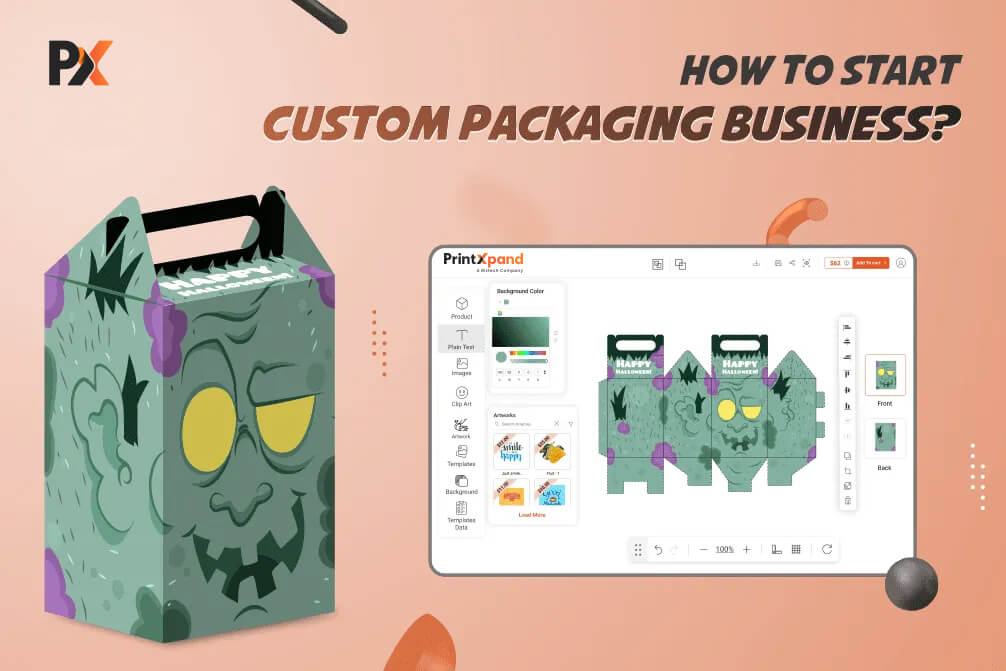Summary
Imagine you have just received a gift, and even before opening it, the packaging itself tells a story; maybe it’s adorned with elegant patterns, embossed with a company logo, or personalized with your name. That feeling of anticipation and excitement is exactly what businesses are striving to create through custom web-to-pack solution.
Packaging has evolved; it is not just protection for products anymore. It is a powerful tool for branding and making a memorable impression. Companies across various industries are realizing that distinctive packaging sets them apart from the crowd and leaves a lasting mark on their customers.
This surge in demand for unique packaging experiences is reshaping the entire packaging industry. Web-to-pack solution businesses have made it easy for both big and small businesses selling custom packaging to design and order customized packaging products online.
But how can you seize this opportunity and start your own web-to-pack business? Let’s see!
Create an Impactful Online Presence for Your Web-to-Pack Solution Business
Your digital platform not only introduces your web-to-pack solution but is also a touchpoint for prospective clients.
Your website isn’t just a digital business card. It is your 24/7 sales representative. Share in-depth content that not only highlights your services but also educates your audience. You can employ high-quality images and videos to visually demonstrate the range of packaging options and customization features you offer.
Your online presence is the virtual gateway through which businesses will discover and engage with you. Craft an inviting and informative digital platform that serves as the foundation for a successful journey in the web-to-pack industry.
Choose a Packaging Model: Static or Parametric
Now, let’s talk about the types of packaging designs you can offer in your web-to-pack business. You have two main choices: static and parametric.
1. Static or Fixed Packaging Model

Imagine you own a packaging business, and a bakery seller comes looking for cupcake boxes. You have a fixed selection of cupcake boxes available in standard sizes, just like those familiar combo meals at your favorite fast-food joint.
Here’s how it works: Your customers visit your web-to-pack storefront, browse through your cupcake packaging options, and choose from the pre-set sizes you provide, such as small, medium, or large cupcake boxes. It is as straightforward as ordering a standard burger with a set combination of ingredients at a fast-food restaurant. This choice is perfect for those who appreciate simplicity and want their packaging needs met quickly.
2. Parametric or Flexible Packaging Style

On the other hand, if a customer is selling custom products, like handmade jewelry. They might want packages of different styles and sizes. This means your customers can decide exactly how big or small they want their jewelry box to be.
They can enter the dynamic size of the packaging. The web-to-pack tool will show the 2D and 3D previews of the box. Once everything looks good, they can confirm the order.
The advantage of 3D preview is that customer can actually see how their box will look. As they will be entering custom sizes, it might be difficult for them to visualize the final outcome. But with the 3D preview, it becomes crystal clear. Moreover, the 2D dielines also indicate the restricted parts which cannot be designed, for better understanding.
Hence, with the flexible or parametric model, you can cater to a wide range of business that requires different size and shapes of boxes for different products.
Decide on the Web-to-Pack Solution Personalization Options
Now, let us get into the nitty-gritty of personalization. This step is about deciding what kind of choices you will offer your clients to make their packaging truly unique.
Material
Consider the materials used in your packaging. Will you offer various options like standard cardboard, eco-friendly materials, or premium finishes? The choice of material can affect the appearance and cost of the packaging.
Sizing and Dimensions
Next up, think about sizes and dimensions. Will your customers have the freedom to specify custom sizes, or will you stick to standard dimensions? Custom sizes might come with additional costs, so it’s essential to decide how this affects pricing.
Exterior vs. Interior Customization
You can just offer exterior customization or go a step further with interior personalization. Exterior customization involves the look of the outer packaging, while interior customization lets customers personalize the inside, too. Your decision might impact pricing, so consider this carefully.
Printing Options
Think about printing choices. Will customers have the option for custom prints, like branding logos or artwork, on the packaging? If yes, add up all the costs carefully!
Additional Features
Decide whether you will be offering any special features or not. This could include things like special finishes, unique opening mechanisms, or add-ons like ribbon ties. Think about how these features might add to the overall cost and how they can enhance the appearance of the packaging.
Color Palette
Determine the color options available. Either you can allow your customers to choose from a wide range of colors, or you can stick to a limited palette. The choice of colors can significantly impact the visual appeal and branding possibilities of the packaging.
Minimum Order Quantity
Consider whether there will be a minimum order quantity. Some customers may want just a few items, while others might require larger quantities. Setting this minimum can affect the flexibility of your services.
Offer 3D Previews

Imagine you are a client preparing to launch a new product. You have a vision for how your packaging should look, but it is challenging to translate that vision into reality. 3D previews bridge this gap, allowing clients to see their packaging designs come to life.
Clients often struggle with abstract concepts when it comes to design. 3D previews empower them to make informed decisions. They can rotate their packaging, zoom in to inspect details, and visualize how the final product will appear. It encourages them to experiment with different colors, materials, and finishes, giving a sense of ownership over the final product.
Moreover, 3D previews act as a safety net, allowing clients to catch and rectify mistakes before production. 3D previews help customers gain confidence in their choices, knowing exactly what they will receive.
Provide Production-ready Files
Production-ready files are the documents that encompass all the necessary specifications for printing and manufacturing. These files ensure that the design, color schemes, dimensions, and layout are precise and consistent.
When clients receive production-ready files, they can seamlessly forward these documents to printing and manufacturing units. These files are formatted in a way that printers and machines can interpret accurately.
Production-ready files undergo thorough checks to eliminate errors. By providing clients with files that are print-ready, the chances of errors and subsequent revisions are significantly reduced.
Certain industries have specific regulations and standards for packaging. Production-ready files are prepared in compliance with these industry requirements. Whether it’s ensuring food safety information is correctly placed or following eco-friendly packaging guidelines, these files adhere to the necessary standards.
Production-ready files serve as a common ground for collaboration between clients, designers, and manufacturers. They facilitate clear communication, ensuring that all parties are on the same page regarding the design specifications.
Conclusion
Whether you are an established player in the industry or a newcomer, a web-to-pack solution offers the gateway to efficiently meeting the demands of a diverse market.
From choosing the right packaging model to personalization options, 3D previews, and production-ready files, each step contributes to creating a seamless experience for your clients.
The future of packaging is digital, and by following these steps, you are well on your way to delivering excellence and redefining the web-to-pack industry.
All product and company names are trademarks™, registered® or copyright© trademarks of their respective holders. Use of them does not imply any affiliation with or endorsement by them.


















